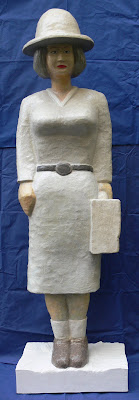
Conrad: "Dark Gold / Dunkles Gold"
Vernissage: Freitag 11. Dezember 2009, 20-23 Uhr
Austellungsdauer: 11.12.09 - 29.01.10, Mi-Fr 16-19 Uhr & nach Vereinbarung
(Galerie geschlossen: 24.12.09-01.01.10)
Als Special Guest wird Hanno Sartorius gegen 21.30 Uhr eine Auswahl romantischer Gedichte austragen.

A King Stays Alone / Ein König Bleibt Allein (2004)
Conrad Artworx, geboren 13.02.1968 in Berlin (West)
1986-1990: Studium der Kunstgeschichte und Germanistik, TU Berlin
CONRAD ist als freischaffender Künstler überwiegend in Berlin tätig, mit diversen Ausstellungen in Galerien, Kunst-Cafes, aber auch in Kulturkooperationen.Zu seinen letzten Projekten gehörten u.a.:
- "Art and Beauty", Kolonie Wedding, 2002
- Kultursommer Wedding, 2003
- Galerie Scherer 8, 2004
- Galerie Freizeitservice, 2005
- Kunst-Cafe Schmidt, 2006
- Ballsaal Glaskasten, 2007
- Kulturinitiative "Westerweiterung", Friedrich- Ebert Stiftung, 2007
- Open-Air-Gallery Friedrichshain/Kreuzberg, 2008
- Kulturfabrik Moabit, 2009
ZU SEINEN BILDERN:
Die Arbeiten von CONRAD beschäftigen sich im Grundsatz mit der Reflektion emotionaler Ambivalenz und wollen sowohl kraftvoll, als auch subversiv deren Widersprüchlichkeit vor Augen führen. In seinen energetischen Bildern werden Zustände im Spannungsfeld von Melancholie und Hoffnung, Liebe und Schmerz, kreativem Zorn und tiefer Traurigkeit thematisiert. Sie pendeln bipolar zwischen Tag und Nacht, zwischen expressiven Abgründen - aber auch tief empfundener Sehnsucht nach Harmonie.
Die Serie "DARK GOLD / DUNKLES GOLD" beinhaltet eine Auswahl spiritueller, ikonographischer und sakraler Arbeiten.
Die Serie "DARK GOLD / DUNKLES GOLD" beinhaltet eine Auswahl spiritueller, ikonographischer und sakraler Arbeiten.























